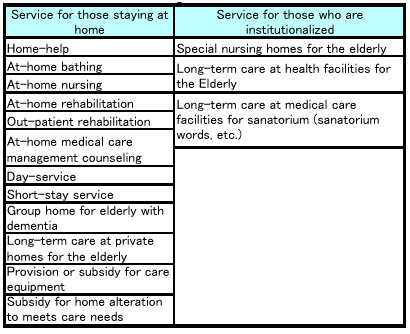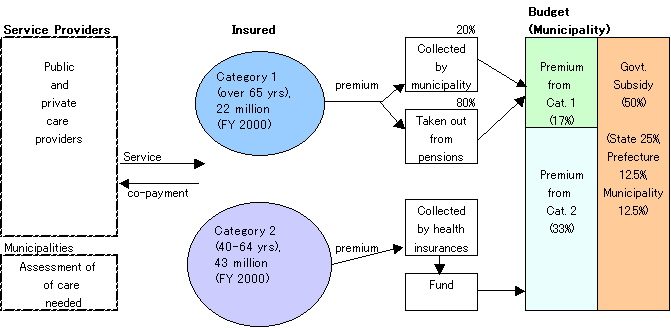
Starting in April 2000, Japan introduced the Long-Term Care Insurance. The insurance system will cover the long-term care of the elderly, which was previously provided partly through the health insurance system and partly by the welfare measures. The main differences between the Long-Term Care Insurance and long-term care provided by the prior system are shown in Table 5.1. The new system grew out of the recognition that, due to changes in the society such as weakened community ties, increase in small-sized families, and increase of working women, financial and psychological burden of family facing the care for the elderly has become unbearably large. The Long-Term Care Insurance is designed to share the burden of caring for the elderly among all members of the society and lessen the burden of the family. In other words, it aims to establish a system that responds to society's major concern about aging, and to assure the citizens that they will receive care, if necessary, and be supported by society as a whole. Furthermore, it is expected to alleviate the financial pressure placed by the care need of an aging society on the health insurance system.
Table 5.1 Differences between New and Old Care Systems

Source:Nihon Iryo Kikaku,"Iryo Hakusho,1998"
The insured persons are those who are aged 65 and over (Category 1) and those between ages of 40 to 64 and are subscribers of health insurance (Category II). The premium is collected through municipality and deducted from pensions for the Category I, and through additional premium to be paid to health insurance for the Category II. Premium amount is determined by each municipality, and thus differs depending on available facilities, in-home services provided, and demand for care services. Premium is income-related, and there will be measures to moderate the burden for low-income persons.
b) Service providedA list of care services is shown in Table 5.2. The services are provided both at home and at institutions depending on the care required by user. The user is free to choose the kind of care and its providers, which can be either public or private.
c) Source of financingThe cost incurred in the Long-Term Care Insurance is financed by premiums, government subsidy and co-payment of users. A part from the co-payment of the users, the cost is financed 50% by premiums (17% by Category I, 33% by Category II in FY2000) and 50% by government subsidy. Within this framework the municipality can determine the rate of premium for the insured of Category 1. It is estimated about 3,000 yen per month on average (FY2000). For the Category 2 insured the rate will be 0.95% of salary in the Government-managed Health Insurance and 0.88% in the Society-managed Health Insurance (FY2000). Co-payment for the services is 10% of the cost, plus, for those in a hospital or an institution, a part of the meal expense.
d) Assessment of the care-needsThe users are classified into 6 categories ("Assistance Required" and "Care Required Level 1 to 5"), depending on the severity of the care need. The upper limit of services provided is determined according to this category. The user must be assessed by the municipality into one of the categories before applying for the services.
Table 5.2 Care under Long-Term Care Insurance

Source: Kenko Hoken Kumiai Rengokai,"Shakai Hosho Nenkan 1999"
Fig.5.1 Diagram Representation of Long-Term Care Insurance

Source: Kenko Hoken Kumiai Rengokai, 1999, MHW, 1999
One of the concerns in introducing the Long-Term Care Insurance is uneven distribution of care facilities throughout Japan, resulting in a shortage of care providing facilities, both private and public, in some regions. The anxiety is expressed, "Insurance, but no Service". The government has formed a plan to increase the public care facilities and to encourage private sector to enter into the field. At the same time, there is also a concern about the quality of care provided by the private sector. The quality control measures need to be set.
2. Response to the rise of insurance premium and the co-paymentAnother issue is the amount of premium. For the insured of the Category I, the premium is deducted from pensions or collected separately by the municipality, and for the Category II the premium of the Long-Term Care Insurance will be added on top of the health insurance premium. There is also a considerable variation in the premium among municipalities. There has been a considerable out-cry from low-income households who cannot bear the premium or/and the co-payment, and as a response some municipalities have reduced the premium or the co-payment for the low-income users.
3. Determination the CategoryAssessing the true requirement of the elderly, and categorizing into 6 categories is very hard. Especially in case of dementia, there have been reports that they are likely to be classified in a lower category.